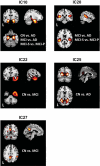Prognostic classification of mild cognitive impairment and Alzheimer's disease: MRI independent component analysis
- PMID: 25194437
- PMCID: PMC4586157
- DOI: 10.1016/j.pscychresns.2014.08.005
Prognostic classification of mild cognitive impairment and Alzheimer's disease: MRI independent component analysis
Abstract
Identifying predictors of mild cognitive impairment (MCI) and Alzheimer's disease (AD) can lead to more accurate diagnosis and facilitate clinical trial participation. We identified 320 participants (93 cognitively normal or CN, 162 MCI, 65 AD) with baseline magnetic resonance imaging (MRI) data, cerebrospinal fluid biomarkers, and cognition data in the Alzheimer's Disease Neuroimaging Initiative database. We used independent component analysis (ICA) on structural MR images to derive 30 matter covariance patterns (ICs) across all participants. These ICs were used in iterative and stepwise discriminant classifier analyses to predict diagnostic classification at 24 months for CN vs. MCI, CN vs. AD, MCI vs. AD, and stable MCI (MCI-S) vs. MCI progression to AD (MCI-P). Models were cross-validated with a "leave-10-out" procedure. For CN vs. MCI, 84.7% accuracy was achieved based on cognitive performance measures, ICs, p-tau(181p), and ApoE ε4 status. For CN vs. AD, 94.8% accuracy was achieved based on cognitive performance measures, ICs, and p-tau(181p). For MCI vs. AD and MCI-S vs. MCI-P, models achieved 83.1% and 80.3% accuracy, respectively, based on cognitive performance measures, ICs, and p-tau(181p). ICA-derived MRI biomarkers achieve excellent diagnostic accuracy for MCI conversion, which is little improved by CSF biomarkers and ApoE ε4 status.
Keywords: AD; Alzheimer׳s disease neuroimaging initiative; Data reduction; MCI.
Published by Elsevier Ireland Ltd.
Figures

References
-
- Arnold SE, Hyman BT, Flory J, Damasio AR, Van Hoesen GW. The topographical and neuroanatomical distribution of neurofibrillary tangles and neuritic plaques in the cerebral cortex of patients with Alzheimer's disease. Cerebral Cortex. 1991;1:103–116. - PubMed
-
- Ashburner J. A fast diffeomorphic image registration algorithm. Neurolmage. 2007;38:95–113. - PubMed
-
- Ashburner J, Friston KJ. Unified segmentation. Neurolmage. 2005;26:839–851. - PubMed
Publication types
MeSH terms
Substances
Grants and funding
LinkOut - more resources
Full Text Sources
Other Literature Sources
Medical
Miscellaneous

